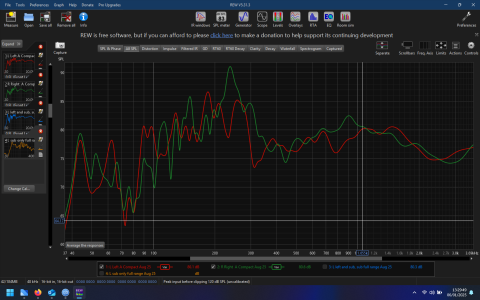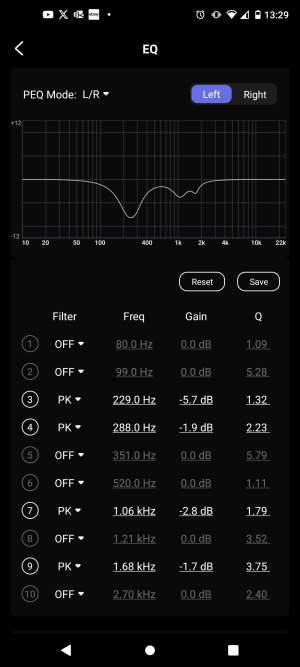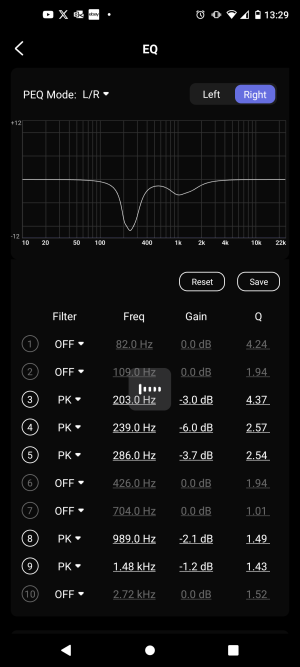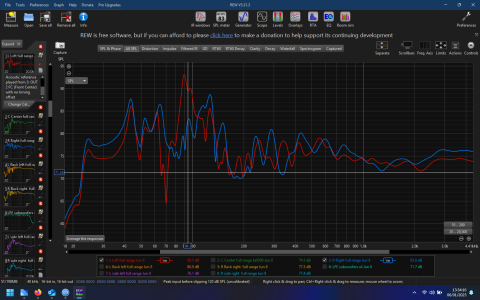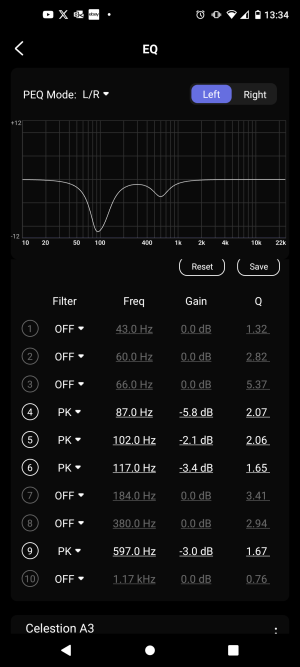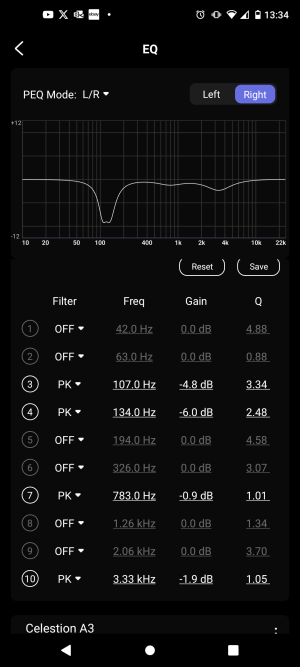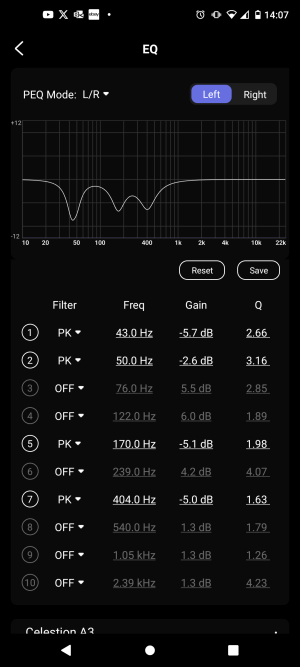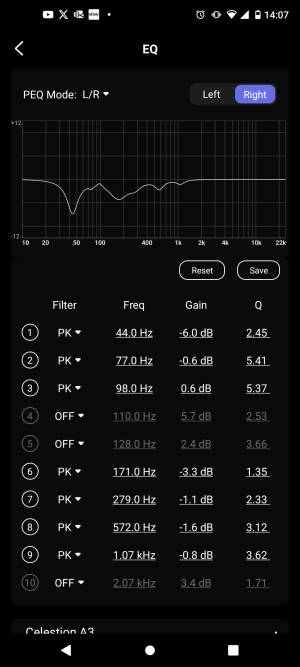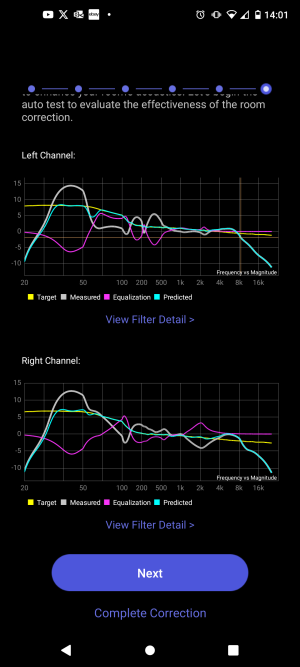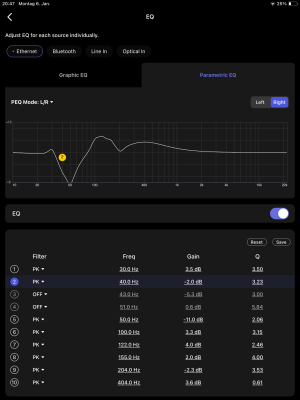You are using an out of date browser. It may not display this or other websites correctly.
You should upgrade or use an alternative browser.
You should upgrade or use an alternative browser.
Room correction
- Thread starter krismusic
- Start date
I'll be using the Wiim to measure the response in my hifi system, but then use the suggest corrections in squeezebox EQ.
Here it is and corrections. It has cleaned up the excessive bass in the room, now to add these into SqueezeDSP (I'm using a squeezebox in that room)
Here it is and corrections. It has cleaned up the excessive bass in the room, now to add these into SqueezeDSP (I'm using a squeezebox in that room)
Attachments
Last edited:
When it's done calculations, modify it, remove any positive values. Then save that preset.
But yeah my systems sound good without RC (for the speakers) RC just sounds different. For subwoofers room correction is a must if it's all over the place. I think with sealed subs response is generally flatter so you might get away without subwoofer EQ.
I have sealed Subs, however in my case its the modes of the room which are hard to come by. With RC it‘s not perfect but better!
Not to mention the soundstage (with L/R) which is better now as well (although it was good before too)
I'll be using the Wiim to measure the response in my hifi system, but then use the suggest corrections in squeezebox EQ.
Here it is and corrections. It has cleaned up the excessive bass in the room, now to add these into SqueezeDSP (I'm using a squeezebox in that room)
Squeezebox has an EQ?
Squeezebox has an EQ?
yeah plugin but apparently it's not working that well.
Let say there’s a 4000 hz boost just turn that eq off? You only keep the cuts?When it's done calculations, modify it, remove any positive values. Then save that preset.
But yeah my systems sound good without RC (for the speakers) RC just sounds different. For subwoofers room correction is a must if it's all over the place. I think with sealed subs response is generally flatter so you might get away without subwoofer EQ.
Let say there’s a 4000 hz boost just turn that eq off? You only keep the cuts?
It's recommended NOT to apply any boosts, that sucks up amp power and harder on the drivers.
It's recommended to only apply cuts.
Yes if Wiim EQ applies say +10 db boost at 4khz I just zero it, or disable it that filter
I will try that out of 10 band 6 were boost between 4 to 8db. 4 bands were cuts.It's recommended NOT to apply any boosts, that sucks up amp power and harder on the drivers.
It's recommended to only apply cuts.
Yes if Wiim EQ applies say +10 db boost at 4khz I just zero it, or disable it that filter
you can edit the preset so create severalI will try that out of 10 band 6 were boost between 4 to 8db. 4 bands were cuts.
1) Auto EQ (boosts and cuts)
2) Cuts only
3) Full range correction
4) 60hz-4khz
Also try the different curves, flat, bk, harmon etc
Also for my speakers I work out what the frequency response of them is, then I only correct in the speakers ability. Ie for standmounts with frequency response down to 60HZ, I wouldn't correct down to 30hz. As with auto that would also mean it's going to apply a lot of boost 20-60hz
With my towers I selected down to 40hz. For my bookshelf speakers I selected 80hz.
That depends if you have a sub, but ideally speaker and subwoofer channel / correction should be independent
I turned off all 6 bands that were boost and now the sound was dull lack sparkling on highs.you can edit the preset so create several
1) Auto EQ (boosts and cuts)
2) Cuts only
3) Full range correction
4) 60hz-4khz
Also try the different curves, flat, bk, harmon etc
Also for my speakers I work out what the frequency response of them is, then I only correct in the speakers ability. Ie for standmounts with frequency response down to 60HZ, I wouldn't correct down to 30hz. As with auto that would also mean it's going to apply a lot of boost 20-60hz
With my towers I selected down to 40hz. For my bookshelf speakers I selected 80hz.
That depends if you have a sub, but ideally speaker and subwoofer channel / correction should be independent
slartibartfast
Major Contributor
- Joined
- Apr 18, 2024
- Messages
- 5,193
I have a couple of boosts in my EQ. It doesn't seem to cause any issues. If we had the ability to run the Evaluation sweep at any time we could see the difference made by turning off filters. The main reason not to use boost filters is that if the dips are caused by nulls then boosting won't help since the boost would be cancelled out by a higher amplitude reflection. If your boosts do make an audible difference then leave them in.I turned off all 6 bands that were boost and now the sound was dull lack sparkling on highs.
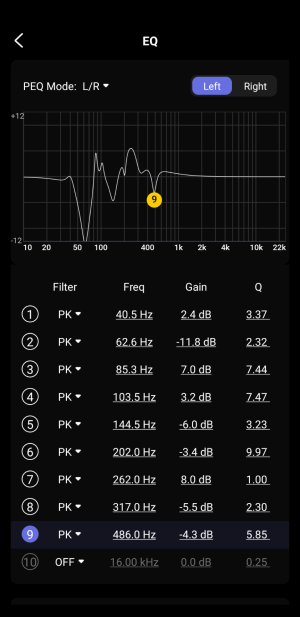
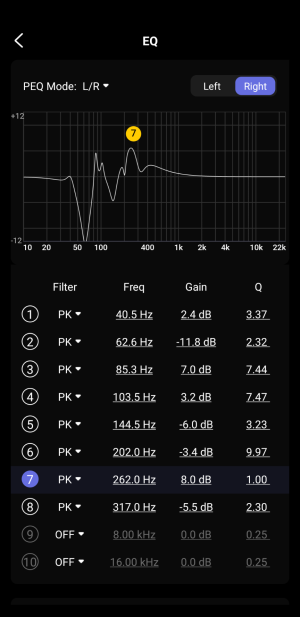
I turned off all 6 bands that were boost and now the sound was dull lack sparkling on highs.
Are you doing full range correction?
Yes 20 to 20khz.Are you doing full range correction?
If you turn off all the boost frequency, would it sound dull?I have a couple of boosts in my EQ. It doesn't seem to cause any issues. If we had the ability to run the Evaluation sweep at any time we could see the difference made by turning off filters. The main reason not to use boost filters is that if the dips are caused by nulls then boosting won't help since the boost would be cancelled out by a higher amplitude reflection. If your boosts do make an audible difference then leave them in.
View attachment 15919
View attachment 15920
I have a couple of boosts in my EQ. It doesn't seem to cause any issues. If we had the ability to run the Evaluation sweep at any time we could see the difference made by turning off filters. The main reason not to use boost filters is that if the dips are caused by nulls then boosting won't help since the boost would be cancelled out by a higher amplitude reflection. If your boosts do make an audible difference then leave them in.
View attachment 15919
View attachment 15920
Exactly! I have also boosts in some areas. It is not a problem at all, used in the way you described…
I just followed what rccarguy to see how it sound. I will just going to enable them back. I don’t think it’s a problem for halo jc 1 knowing it’s one of the most powerful and expensive amp that ever made. It can drive any speakers known to man down to 1 ohms.Exactly! I have also boosts in some areas. It is not a problem at all, used in the way you described…
I just followed what rccarguy to see how it sound. I will just going to enable them back. I don’t think it’s a problem for halo jc 1 knowing it’s one of the most powerful and expensive amp that ever made. It can drive any speakers known to man down to 1 ohms.
Well, I would be sensible with boosting nevertheless!
If you boost too much, you might get compression artifacts.
In the early days of WiiM RC, this was a general issue - at least in my case.
With all 10 bands enable, sound was great than rc off. I think rc have gone a lot of under the hood improvements. I like soundstage that is large as monument. In some occasion, I use Yamaha dsp to give the soundstage as large as palace at 360 since it uses 4 speakers to simulate dsp while the main just produce direct sound. It uses 6 speakers. Main speakers produce direct sound while the other 4 a combination of early reflection and reverberation. I’m one of the very few who like dsp but mostly users stick to straight mode.Well, I would be sensible with boosting nevertheless!
If you boost too much, you might get compression artifacts.
In the early days of WiiM RC, this was a general issue - at least in my case.
Similar threads
- Replies
- 47
- Views
- 2K
- Replies
- 4
- Views
- 351
- Question
- Replies
- 3
- Views
- 207
- Replies
- 43
- Views
- 1K
- Suggestion
- Replies
- 2
- Views
- 366

